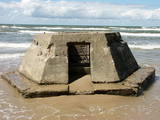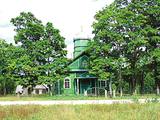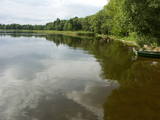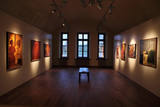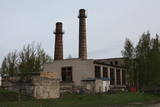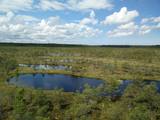| Nr | Nosaukums | Apraksts |
|---|---|---|
|
No baterejas līdz mūsdienām ir saglabājušās dzelzsbetona dzota paliekas, kas ilgstošā vēja un viļņu darbības rezultātā, noskalojot krastu, ir noslīdējušas līdz pat liedagam. Interesants vēstures piemineklis, kura liktenis ilgtermiņā ir nojaušams – tas pazudīs zem jūras līmeņa.
|
||
|
Ismeru vecticībnieku kopienas lūgšanu nama celtniecība tika
uzsākta Ismeru ezera krastā 1912. gadā pēc Vitebskā apstiprināta
plāna. Pateicoties iedzīvotāju ziedojumiem, dievnamu uzbūvēja divu
gadu laikā. Ismeru draudze pastāv jau no 1861. gada.
|
||
|
Ziņas par lībiešu pāriešanu pareizticībā sniedz restaurācijas laikā (pagājušā gadsimta deviņdesmitie gadi) Kolkas luterāņu baznīcas tornī (sk. arī tālāk) atrastais dokuments, kas tur ievietots 1885. gadā baznīcas celšanas laikā. Tas vēstī, ka lībiešu pāriešana pareizticībā vai, tā sauktajā, ķeizara ticībā, „nav saistīta ar ticības pārliecību, bet tā ir līdzeklis tikt pie zemes priekšrocībām vai baudām." Pareizticīgo draudze 1885. gadā iegādājas zemi no barona Osten - Zakena. Uz tās 1890. gadā uzcelta baznīca, priestera māja un skolas ēka. Visas ēkas saglabājušās līdz mūsdienām. Baznīcai ir sava draudze un dievkalpojumi notiek reizi mēnesī. Atrodamas ziņas, ka Kolka ir vienīgais lībiešu krasta ciems, kur 19. gs. deviņdesmitajos gados uzcēla pareizticīgo baznīcu. Baznīcas zvans savu vietu "ieņēmis" 1936. gadā. Padomju laikā baznīcu izmantoja kā kapliču, bet mūsdienās tā pilda savu sākotnējo lomu. |
||
|
Vientuļš, mežu ieskauts un sens ceļš starp Košragu un
Dūmeli, ar ko saistīti daudzi interesanti fakti gan par Pitragupes dzirnavām,
kas ne reizi tā arī nav malušas (vēl manāmas uzbērumu paliekas), par kāda
avarējuša kuģa tvaika katlu, ko vietējais barons te izmantojis darvas tecināšanai,
gan kādreizējo zirgu ceļu, kas šķērsojis Bažu purvu, gan iespaidīgo Dūmeles
dižakmeni.
|
||
|
Ar mežiem, purviem un ezeriem (Riču, Sila u.c.) bagāta teritorija Latvijas - Baltkrievijas pierobežā. Galvenās aizsargājamās dabas vērtības - dažāda veida purvu, mežu un ezeru biotopi un tajos mītošās augu un dzīvnieku sugas. Ezeru krastos, kurus iecienījuši vietējie atpūtnieki, atrodas vairākas naktsmītnes. Ilgas muiža (celta 19. gs. kā medību pils) ir Daugavpils Universitātes studentu prakses vieta. Silenes dabas parkā ietilpst arī Glušonkas purva un Ilgas dabas liegumi.
|
||
|
Dievnamu (atrodas Skujenes – Vecpiebalgas ceļa malā) 1872. g. cēla pirmais izglītotais latviešu arhitekts Jānis Frīdrihs Baumanis (1834. – 1891.), kas ir vairāku pazīstamu celtņu – J. Vītola Mūzikas akadēmijas, Rīgas cirka, Valsts bankas u.c. ēku projekta autors. Padomju laikā Māļu baznīcā atradās tukšās taras pieņemšanas punkts, bet mūsdienās – saglabājies tikai ēkas ārējais veidols. Baznīca apskatāma arī no iekšpuses. |
||
|
Stādu audzētavas "Bērziņi" pamatdarbība ir daudzgadīgo puķu, tajā skaitā zāļveida ziemciešu, paparžu un peoniju stādu audzēšana. Saimniecībā veido peoniju kolekcijas stādījumus. Pēc pasūtījuma pieaudzē puķu traukus un piramīdas ar vasaras puķēm. Saimniecība piegādā un uzstāda moduļu ''zaļās sienas'' vertikālai apzaļumošanai. Ziemā gatavjam Ziemassvētku dekorus un materiālus floristikai. |
||
|
Bijušais Baltijas ledus ezera senkrasts. Varam tikai iedomāties ainavu pirms vairāk nekā 10 000 gadiem, kad Kurzemes pussalu klāja tundrai līdzīga veģetācija un pret stāvo senkrastu triecās ledaina ezera viļņi, kuros peldēja dažāda lieluma aisbergi. Mūsdienās vairāk nekā 20 km garā (Slīteres nacionālā parka teritorijā – ap 9 km garš posms) un līdz 42 m augstā krauja ir viena no iespaidīgākajām šāda veida reljefa formām Latvijā. Tās piekājē plešas Piejūras zemienes Irves (nosaukums tiek skaidrots ar lībiešu „īrva, īra" – „stirna") līdzenums – kādreizējais Baltijas ledus ezera dibens. Zilo kalnu krauju daudzviet šķērso nelielu strautu un upīšu (Pitragupe, Lorumupe, Kaļķupe, Mazupe u.c.) ielejas, veidojot sazarotas un pat ļoti sarežģītas gravu sistēmas, kas īpaši iespaidīgas izskatās bezlapu periodā. Daudzviet gan pašas kraujas, gan to šķērsojošo gravu un to sānu gravu krastos atsedzas pārsvarā neliela izmēra Narvas svītas smilšakmens atsegumi. Tie ir Latvijā vecāki nogulumieži, kas dabisku atsegumu veidā parādās virszemē. Neskatoties uz iespaidīgajiem izmēriem, visā Zilo kalnu garumā ir tikai dažas vietas ar plašākiem skatu punktiem (skatu tornis pie Dundagas – Mazirbes ceļa, skats no Šlīteres bākas, skats no Mežlīdumiem) un vietas, kur var patiesi izbaudīt senkrasta varenību (skati uz Zilo kalnu krauju un gravām pie Cirstes – Mazirbes ceļa, Cirstes – Riepaldu ceļa, Mežlīdumu un Vīdales - Melnsila ceļa). Te vērts atbraukt arī pavasarī, kad Zilo kalnu nogāzes slīgst mežloku (lakši) spilgtajā zaļumā. |
||
|
Daudzfunkcionāls laikmetīgās mākslas komplekss, kultūras un izglītības centrs Daugavpils/Dinaburgas cietoksnī, artilērijas Arsenāla ēkā. Vienīgā vieta Austrumeiropā, kur tiek piedāvāta iespēja iepazīties ar pasaules slavenā mākslinieka abstraktā ekspresionisma pamatlicēja Marka Rotko oriģināldarbiem. Rotko muzejs piedāvā aplūkot patstāvīgās un mainīgās ekspozīcijas. Patstāvīgās ekspozīcijas veido Marka Rotko darbu oriģināli un reprodukcijas, digitālā ekspozīcija par mākslinieka dzīvi un daiļradi, kā arī kultūrvēsturiskās ekspozīcijas. Mainīgās ekspozīcijas - Latvijas, Eiropas un pasaules mākslinieku darbu izstādes. |
||
|
Pajumäe ir maza, jauka bioloģiskā saimniecība, kas atrodas zaļajā Mulgimaa un ražo dažādus piena produktus. Varēsiet apskatīt visus piena ražošanas posmus – no govīm ganībās līdz pat apstrādei pienotavā. |
||
|
Karostas katlu māja padomju laikā gadu desmitiem tikusi izmantota pilsētas apkures nodrošināšanai. Šobrīd tā ir ir pamesta un degradēta teritorija, kas lieliski pārskatāma no blakus esošajām Karostas ielām.
|
||
|
Kapteiņa A. Bertholda vecāku kapu
vieta ar savdabīgu kapa pieminekli.
|
||
|
Atpūtas komplekss „Ezerkrasti” atrodas Latvijas otra lielākā – Rāznas ezera ziemeļu krastā. No kafejnīcas "Kastanis" logiem paveras viens no skaistākajiem Latvijas ezeru skatiem! Latviešu virtuve: zivju, skābeņu un aukstā zupa, miežu biezputra, pelēkie zirņi ar speķi, sautētas cūkgaļas ribiņas ar kāpostiem, zivju ēdieni, mājas sieri un pildīti āboli ar medu. Īpašais ēdiens: kartupeļu dračenka – sarīvēti un sacepti kartupeļi ar gaļu un sīpoliem. |
||
|
Viens no Latvijas lielākajiem (6192 ha) augstā tipa purviem ar ļoti izteiktām purva ezeriņu, lāmu un ciņu ainavām. Lielajam Ķemeru tīrelim ir ne tikai nozīmīga loma kā plašākas apkārtnes hidroloģiskā režīma un mikroklimata uzturētājam, bet tā ir arī putniem starptautiski nozīmīga vieta un viens no lielākajiem sērūdens veidošanās reģioniem. Purva austrumu malā - Kalnciema – Kūdras ceļa malā (3,4 km no Rīgas – Ventspils šosejas) uzstādīts informācijas stends, kas vēsta par Lielā Ķemeru tīreļa apsaimniekošanas pasākumiem un purvu lomu dabā un cilvēku dzīvē. 2013. gadā atklāta atjaunotā Ķemeru Purva taka ar koka laipām un skatu torni. Izveidotas 2 dažādu garumu riņķveida maršruti. |
||
|
Neparastas formas priede, kuru pēc nostāstiem stādījis zviedru karalis Ziemeļu kara laikā.
|
||
|
Lejpus Inčukalna – Valkas autoceļa, Brasla plūst pa ainavisku ieleju, kas ir ap 300 m plata un līdz 30 m dziļa. To var uzskatīt par vienu no skaistākajiem Latvijas upju straujteču posmiem, kur vareni atsegumi (Braslas ieži - ) paceļas teju vai katrā upes līkumā (izņemot pašu lejteci). Ziemā uz dažiem no tiem (Krauļukalna iezis, Jāņavārti) veidojas neparastu formu leduskritumi. Pie Braslas ūdenskrātuves upes kreisajā krastā sākas un tālāk iepretim Braslas zivju audzētavai turpinās Aņītes ieži - smilšakmens atsegumu virkne 1 km garā posmā. Aņītes ieži ir vairākas no 2 m līdz pat 35 m augstas, ar gravām atdalītas smilšakmens klintis. Otrā - Braslas labajā krastā slejas tādi ievērojami atsegumi kā Varšavu iezis, Krauļukalna iezis, Jāņavārti, Slūnu iezis, Virtakas un Buļu iezis. Kā tos vislabāk iepazīt? Ar laivu var sākt braucienu no minētā autoceļa vai pat augstāk – no Straupes. Otras variants – gājiens ar kājām gar upes labo krastu. Šajā gadījumā gan ir jārēķinās ar samērā ekstrēmu iešanu un jāpadomā par tālāko maršrutu, nonākot pie Braslas ietekas Gaujā. |
||
|
Krimuldas muiža pirmoreiz rakstos ir minēta jau 15. gs. Tagad redzamā Krimuldas pils lepni slejas Gaujas senlejas labā pamatkrasta nogāzē iepretim Siguldas Gaisa tramvajam. Gan uz pili (no pretējā krasta un no Gaisa tramvaja), gan no pils paveras lielisks Gaujas senlejas skats. Krimuldas pili būvēja 19. gs. neoklasicisma stilā un tās īpašnieks bija firsts Līvens. 20. gs. 20 gados pēc pils atsavināšanas tā nonāca Latvijas Sarkanā Krusta īpašumā, kas izveidoja bērnu sanatoriju. Mūsdienās muižas pilī atrodas rehabilitācijas slimnīca "Krimulda", bet no saimniecības ēkām ir saglabājušies muižas staļļi, kūts, kalpu, pārvaldnieka un t.s. Šveices māja. Krimuldas muižas apskates nolūkos tiek organizētas izglītojošas ekskursijas, piedāvā naktsmītnes. |
||
|
Pokaiņu mežs atrodas 13 kilometru attālumā no Dobeles, braucot Īles virzienā. Tas, izvietojies uz stāviem pauguriem un dziļām ielejām, veido neparasti gleznainu ainavu. Mežā grupās, kaudzēs, akmens upēs un valnīšos, atrodas slavenie Pokaiņu akmeņu krāvumi. Krāvumi daudziem cilvēkiem liek sajust savdabīgus enerģijas strāvojumus - vieni redz vīzijas, bet citi – uztver informācijas plūsmu. Takas ved pa pagurainu apvidu.
|
||
|
Iespaidīga koka celtne un izcils koka arhitektūras piemērs, kuru pamanīs katrs Plateļu apmeklētājs! Plateļu baznīca ir viens no Lietuvas vecākajiem koka dievnamiem. Pašreiz redzamais ir būvēts 1744. g., bet zvanu tornis – 1899. g. Dienvidos no baznīcas plešas Plateļu muižas parks. |
||
|
Atrodas Teirumnīku purva vidusdaļā pie tāda paša nosaukuma ezera. Līdz tam nokļūstam pa laipu taku, kas šķērso purvu ( 0,8 km). Lieliska iespēja iepazīt augsto purvu, purva ezeru un apkārtnes dabu.
|
||
